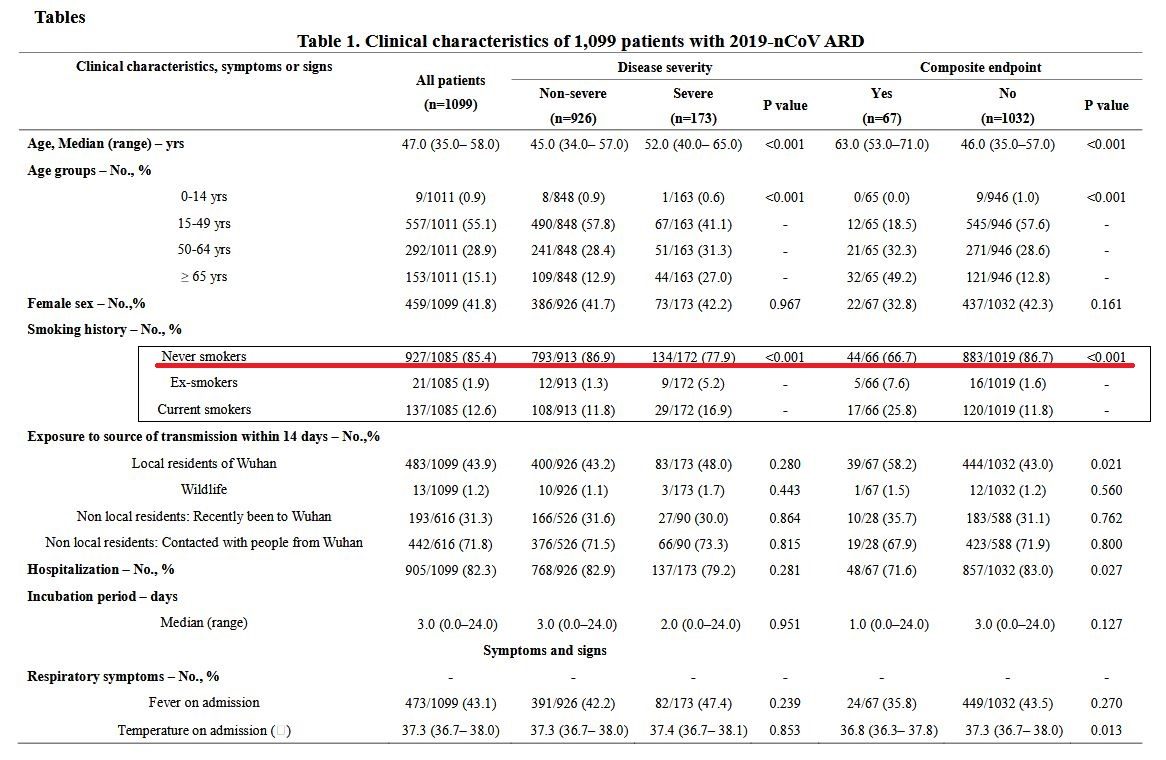Comment: This won't surprise Sott.net readers, but we bet the doctors and scientists examining the clinical characteristics of this disease didn't expect the results they got...
Great find by Joe L:
...new study ... claims that of the 1,099 Chinese people who contracted 2019-nCoV which were studied, 85.4% (927 people) were never-smokers, while only 12.6% (137 people) were current smokers and only 1.9% (21 people) were ex-smokers.Here's a link to the pdf study. And here's part of Table 1 from the study (click to enlarge):
Comment: To be clear, these were people who not only tested positive for presence of the virus, they became ill, and about half of them became "severely" ill.
According to the WHO:
More than half of all adult men in China are regular smokers.According to the World Bank, the figure is 48%. It's really only in the West that the figure is down around 15%. Eastern Europeans and Russians are heavy smokers. Seems the Chinese are too.
Comment: In a 2015 study in The Lancet, cited here, they estimated that 68% of Chinese men are smokers, but just 3.2% of women.
What might explain the comparative immunity of smokers? My first suggestion was that smokers in China who are already being forced to smoke outside are in effect being quarantined. But they'll still be spending a lot of time with non-smokers, so it's only a partial quarantine.
A better explanation might be that smokers have more mucus in their lungs than non-smokers, and it's harder for a virus to get through this than with the thinner layers in non-smokers' lungs.
Comment: That's one factor, but there's more to it than that. See below for links to information about how smoking tobacco works medically.
The same may have been true during the Plague of 1665:
In 1665, London was rocked by an outbreak of bubonic plague. It was believed that the disease was spread by bad smells and invisible 'miasmas', so people used smoke to protect themselves. Tobacco was especially recommended to ward off the plague, and those tasked with disposing of the dead smoked a clay pipe to keep the disease at bay.The bubonic plague was not a virus, but a bacterium - Yersinia pestis - but if infection with the Plague entailed inhaling the bacteria, the thicker mucus in smokers' lungs might well have been equally difficult for bacteria to penetrate.
Comment: There is compelling evidence that the Black Death was not an outbreak of bubonic plague, but was in fact caused by a hemorrhagic virus. This case is synthesized in the book Return of the Black Death, in which Susan Scott and Christopher Duncan from Liverpool University carefully put all the available clues together, tracking the plague from its first appearance out of nowhere and chronicling its unprecedented catastrophic effects on European civilization - death on a scale that is unimaginable, and which could very well happen again, but which is NOT this current novel coronavirus outbreak.
For more, see: New Light on the Black Death: The Viral and Cosmic Connection
Whatever the explanation, it rather looks as if smokers are afforded greater protection against the new coronavirus than non-smokers. Furthermore, when they do catch the virus, it seems that smokers generally get non-severe cases.
In which case, shouldn't medical advice about preventing coronavirus infection include... Start Smoking?
Perhaps it could be argued that the results of one study are insufficient to merit such advice. But if a whole set of studies show that smokers are genuinely be protected from coronavirus, shouldn't that be the advice?
Using the above study's figures, how much more likely are non-smokers to get 2019-nCoV than smokers?
Assuming that there is a population N1 (e.g. city of Wuhan) that are half smokers and half non-smokers, and that these supply patients to an infected subpopulation N2 (e.g. 1099 people), in which 85% are non-smokers and 15% are smokers, then the probability Pn of a non-smoker becoming infected is (0.85.N2)/(0.5.N1) , and the probability Ps of a smoker becoming infected is (0.15.N2)/(0.5.N1). And so non-smokers are Pn/Ps times more likely to become infected than smokers. Pn/Ps = 0.85/0.15 = 5.66.
I've lumped in smokers with ex-smokers. Using the exact figures of 85.4% for Pn and 14.6% for Ps, Pn/Ps = 5.85
So non-smokers are nearly 6 times more likely than smokers and ex-smokers to become infected.





So with that, its time to spark up 2 joints this morning, and then I will smoke 2 more for good luck.
B.C.